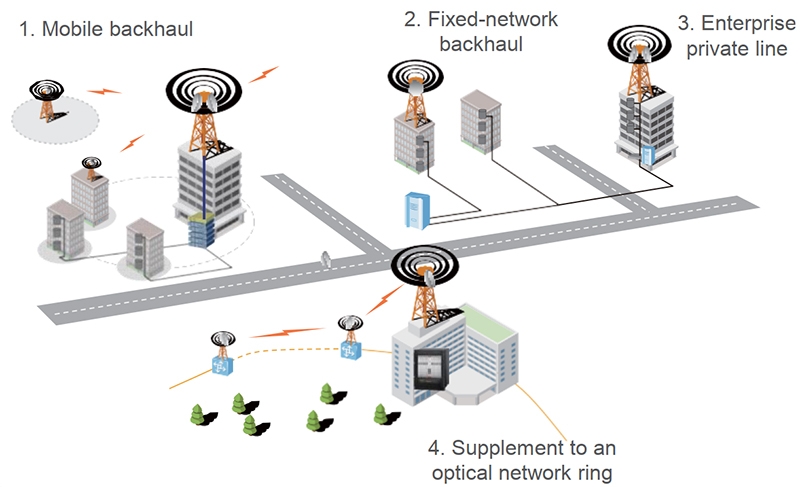The RTN 380A is a full-outdoor microwave transmission device operating at 71–76 or 81–86 GHz frequency bands (E-band). The RTN 380A is applicable to mobile communications networks or dedicated networks. It features large capacity, low intersite interference, and rich spectrum resources. It provides large-capacity microwave backhaul or aggregation links and can be used as a supplement to metro optical networks.
Table 1 shows the quick spec.
|
Model |
Huawei OptiX RTN 380A |
|
Microwave Type |
IP microwave over Native Ethernet/PWE3 Ethernet |
|
Frequency Band |
71–76/81–86 GHz |
|
Channel Spacing |
62.5 MHz, 125 MHz, 250 MHz, 500 MHz, 750 MHz, 1000 MHz |
|
Modulation Scheme |
BPSK, QPSK, 8PSK, 16QAM, 32QAM, 64QAM, 128QAM, 256QAM, 512QAM |
|
Capacity |
• Maximum air-interface bandwidth: 6 Gbps • Maximum air-interface throughput: 7.6 Gbps • Switching capacity: 30 Gbps |
Figure 1 shows the Huawei OptiX RTN 380A Application Scenarios.

Huawei OptiX RTN 380A provides these features:
(1) Ultra-High Bandwidth and High Spectral Efficiency
• Large capacity: provides microwave backhaul or aggregation links with 7.6GE airinterface capacity.
• 10GE ports: provides 10GE SFP optical ports and supports 10GE to site.
• Large channel bandwidth: provides 62.5 MHz, 125 MHz, 250 MHz, 500 MHz, 750MHz, and 1000MHz channel bandwidth.
• High modulation mode: provides a modulation scheme of up to 512QAM.
• Super Dual Band: works as a slave device to bond with the RTN 900 to provide the Super Dual Band solution, or works as a master device to bond with the RTN310/320/380A/905 1E/905 2E/third-party devices to provide the Super Dual Band solution. Through this solution, 10 Gbps microwave links with a maximum transmission distance of 10 km can be provided. In addition, through the Super Dual Band Relay solution, the transmission distance of E-band links can be
extended further.
• AMAC: supports adaptive modulation and adaptive channel bandwidth (AMAC) to ensure the transmission of high-priority services.
(2) Easy Deployment & Maintenance
• Features a small size, light weight, zero footprint installation, fast deployment, and easy maintenance.
• Supports connection to NEs at a site through WLAN, implementing contactless maintenance.
• Supports mobile commissioning and configuration during site deployment, making operations convenient.
• Supports use of the U2000 to implement E2E management, such as service deployment and real-time performance monitoring.

Table 2 shows the comparison.
|
Model |
Huawei OptiX RTN 380 |
Huawei OptiX RTN 380A |
|
Microwave Type |
• IP microwave over Native Ethernet/PWE3 Ethernet • Microwave for transmitting CPRI services |
IP microwave over Native Ethernet/PWE3 Ethernet |
|
Frequency Band |
71–76/81–86 GHz |
71–76/81–86 GHz |
|
Channel Spacing |
62.5 MHz, 125 MHz, 250 MHz, 500 MHz, 750 MHz |
62.5 MHz, 125 MHz, 250 MHz, 500 MHz, 750 MHz, 1000 MHz |
|
Modulation Scheme |
QPSK Strong, QPSK, 16QAM Strong, 16QAM, 32QAM, 64QAM |
BPSK, QPSK, 8PSK, 16QAM, 32QAM, 64QAM, 128QAM, 256QAM, 512QAM |
|
Capacity |
Air-interface capacity: 3.2 Gbps Air-interface throughput: 4 Gbps Switching capacity: 8 Gbps |
• Maximum air-interface bandwidth: 6 Gbps • Maximum air-interface throughput: 7.6 Gbps • Switching capacity: 30 Gbps |
Huawei OptiX RTN 380A Specification |
|
|
Microwave Type |
IP microwave over Native Ethernet/PWE3 Ethernet |
|
Frequency Band |
71–76/81–86 GHz |
|
Channel Spacing |
62.5 MHz, 125 MHz, 250 MHz, 500 MHz, 750 MHz, 1000 MHz |
|
Modulation Scheme |
BPSK, QPSK, 8PSK, 16QAM, 32QAM, 64QAM, 128QAM, 256QAM, 512QAM |
|
Capacity |
• Maximum air-interface bandwidth: 6 Gbps • Maximum air-interface throughput: 7.6 Gbps • Switching capacity: 30 Gbps |
|
RF configuration |
Supports 1+0, 2+0, 1+1 HSB, CCDP, and multi-direction configuration |
|
Port Type |
Auxiliary port: USB port, RSSI port, NMS port Service port: Two 10GE optical ports, two fixed GE electrical ports (one of which can be used as a power over Ethernet (P&E) port) |
|
Service Type |
• Native Ethernet services: E-Line, E-LAN • PW-based Ethernet services: E-Line, E-Aggr, E-LAN (VPLS) |
|
NMS |
U2000-T, Web LCT, SNMP, built-in web-based NMS |
|
ETH OAM |
IEEE 802.1ag, IEEE 802.3 ah, ITU-T Y.1731 |
|
Key Features |
AMAC, ATPC, ERPS, PLA, QoS/HQoS, Bandwidth Notification, TWAMP Light, Anti-theft, Super Dual Band |
|
Clock Features |
• Supported clock sources: microwave link clock, synchronous Ethernet clock • IEEE 1588v2 time synchronization. • ITU-T G.8275.1 time synchronization |
|
Power Supply Mode |
P&E, generally used in conjunction with the RTN PI |
|
Antenna |
• Dish antenna: 0.2 m, 0.3 m, 0.6 m • Panel antenna: 0.3 m • Wide-beam antenna: 0.3 m x 0.077 m |
|
Dimensions |
285 mm x 265 mm x 73 mm |
|
Typical Power Consumption |
39W |
|
Environment |
• Temperature: –33ºC to +55ºC • Humidity: 5% to 100% |